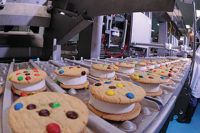Cafeteria Food Fight
Having successfully pushed soft drinks out of schools, some parents and nutritionists are taking on flavored milk.
Dear Ann Landers: I serve my own children white milk only. My neighbor allows her kids to drink chocolate milk, which they buy at school. I don’t like that and think she should stop. What should I do?--Sugarless in Seattle
Dear SIS: MYOB.
I made up that letter, of course. But if ever a question called for Ann’s classic “mind your own business,” this is it.
Having successfully pushed soft drinks out of schools, some parents and nutritionists are taking on flavored milk. I shed no tears over the ouster from school vending machines of empty-calorie, no-nutrient colas and uncolas. This attack on flavored milk is another story.
As children headed back to class in August, the selling of chocolate milk in school cafeterias received a fair hearing in newspapers. The New York Times wrote a news article and the Los Angeles Times printed a point-counterpoint between a University of Vermont dietician and a Yale University psychologist.
The New York Times quotes two moms who hold different views. One feeds her children cookies, ice cream and candy at home but objects to chocolate milk in schools. The other said she doesn’t make a big deal of her 7-year-old son grabbing a carton of flavored milk in the cafeteria because she doesn’t want him to have issues around food.
In the Los Angeles Times, I read the most bizarre sentence ever written by a nutrition advocate: “A little bit of added sugar in the diet is fine, but what people need to realize is that if you use it all up in your milk and your cereal, you won’t have any left for dessert.” Having just said no to chocolate milk, she’s now saying yes to sugary dessert?
Here’s a recap of the issues, as I see them:
• How do schools ensure that children receive the nutrients they need?
• One way is to serve milk, a nutrient-rich food that is beneficial to the growth and development of school-age children.
• Some children do not like plain, unflavored milk, and if they don’t drink it, they miss out on the product’s nutritional value.
• Schools do serve chocolate milk (made with added sugar), which children do drink, thus consuming needed proteins, vitamins and carbohydrates.
• Some parents object to schools selling any foods with added sugars and demand a halt to the practice.
I spent the last month trying to understand the arguments of both sides and concluded this is about more than five added teaspoons of sugar in milk. It is about who has a say in raising America’s children. Is it the child’s parent? Another parent? The government?
Some parents can’t afford to feed their children. Others can but do not have the skills to prepare a healthy meal, or sadly, have no interest in doing so. Enter the government. School breakfast and lunch programs matter because they deliver the only healthy foods some children will eat that day. Schools do have an obligation to serve healthy, nutrient-dense high-fiber foods and beverages that children will eat. Cafeteria managers have to cater to their customers’ preferences. They serve chocolate milk because children like it.
Parents are also the customer of the school-lunch manager and they are now exerting their influence, unduly in some cases, it seems to me. Parents who oppose sugary foods and drinks can ban them from their own dining tables, but they should not deprive other parents and children the choice of chocolate milk. The anti-sugar crowd must allow other parents to make their own food choices for their own children.
Dairy interests have done a good job of supporting their case. They’ve published studies and posted a video summary of the results to YouTube (See “Chocolate Milk Is Tasty Nutrition,” http://tinyurl.com/36bq23r.). The dairy industry does not want to see a consumer favorite pushed out of cafeterias.
Dairy foods, like children, belong in school.
Dear Ann Landers: I serve my own children white milk only. My neighbor allows her kids to drink chocolate milk, which they buy at school. I don’t like that and think she should stop. What should I do?--Sugarless in Seattle
Dear SIS: MYOB.
I made up that letter, of course. But if ever a question called for Ann’s classic “mind your own business,” this is it.
Having successfully pushed soft drinks out of schools, some parents and nutritionists are taking on flavored milk. I shed no tears over the ouster from school vending machines of empty-calorie, no-nutrient colas and uncolas. This attack on flavored milk is another story.
As children headed back to class in August, the selling of chocolate milk in school cafeterias received a fair hearing in newspapers. The New York Times wrote a news article and the Los Angeles Times printed a point-counterpoint between a University of Vermont dietician and a Yale University psychologist.
The New York Times quotes two moms who hold different views. One feeds her children cookies, ice cream and candy at home but objects to chocolate milk in schools. The other said she doesn’t make a big deal of her 7-year-old son grabbing a carton of flavored milk in the cafeteria because she doesn’t want him to have issues around food.
In the Los Angeles Times, I read the most bizarre sentence ever written by a nutrition advocate: “A little bit of added sugar in the diet is fine, but what people need to realize is that if you use it all up in your milk and your cereal, you won’t have any left for dessert.” Having just said no to chocolate milk, she’s now saying yes to sugary dessert?
Here’s a recap of the issues, as I see them:
• How do schools ensure that children receive the nutrients they need?
• One way is to serve milk, a nutrient-rich food that is beneficial to the growth and development of school-age children.
• Some children do not like plain, unflavored milk, and if they don’t drink it, they miss out on the product’s nutritional value.
• Schools do serve chocolate milk (made with added sugar), which children do drink, thus consuming needed proteins, vitamins and carbohydrates.
• Some parents object to schools selling any foods with added sugars and demand a halt to the practice.
I spent the last month trying to understand the arguments of both sides and concluded this is about more than five added teaspoons of sugar in milk. It is about who has a say in raising America’s children. Is it the child’s parent? Another parent? The government?
Some parents can’t afford to feed their children. Others can but do not have the skills to prepare a healthy meal, or sadly, have no interest in doing so. Enter the government. School breakfast and lunch programs matter because they deliver the only healthy foods some children will eat that day. Schools do have an obligation to serve healthy, nutrient-dense high-fiber foods and beverages that children will eat. Cafeteria managers have to cater to their customers’ preferences. They serve chocolate milk because children like it.
Parents are also the customer of the school-lunch manager and they are now exerting their influence, unduly in some cases, it seems to me. Parents who oppose sugary foods and drinks can ban them from their own dining tables, but they should not deprive other parents and children the choice of chocolate milk. The anti-sugar crowd must allow other parents to make their own food choices for their own children.
Dairy interests have done a good job of supporting their case. They’ve published studies and posted a video summary of the results to YouTube (See “Chocolate Milk Is Tasty Nutrition,” http://tinyurl.com/36bq23r.). The dairy industry does not want to see a consumer favorite pushed out of cafeterias.
Dairy foods, like children, belong in school.
Looking for a reprint of this article?
From high-res PDFs to custom plaques, order your copy today!






